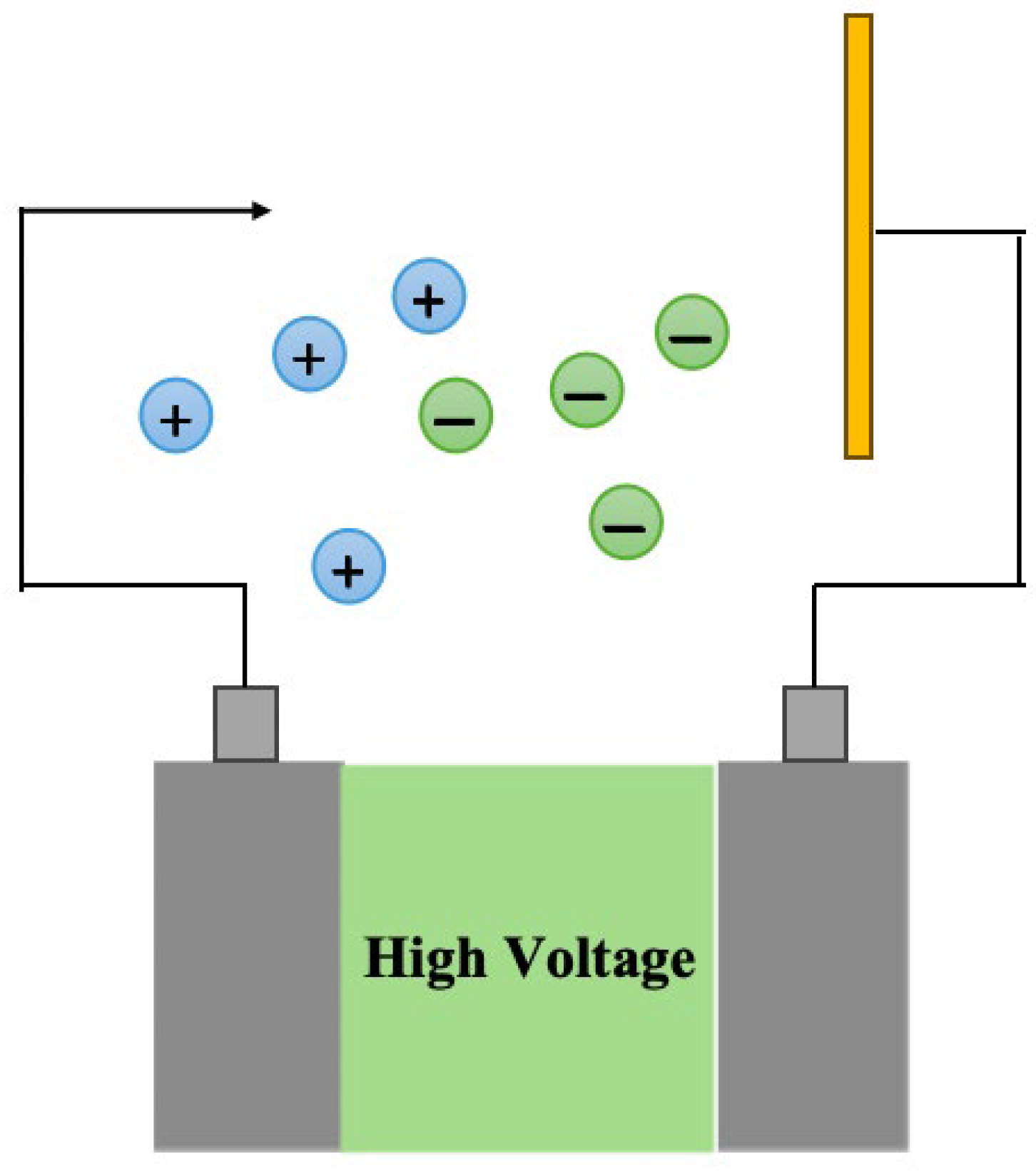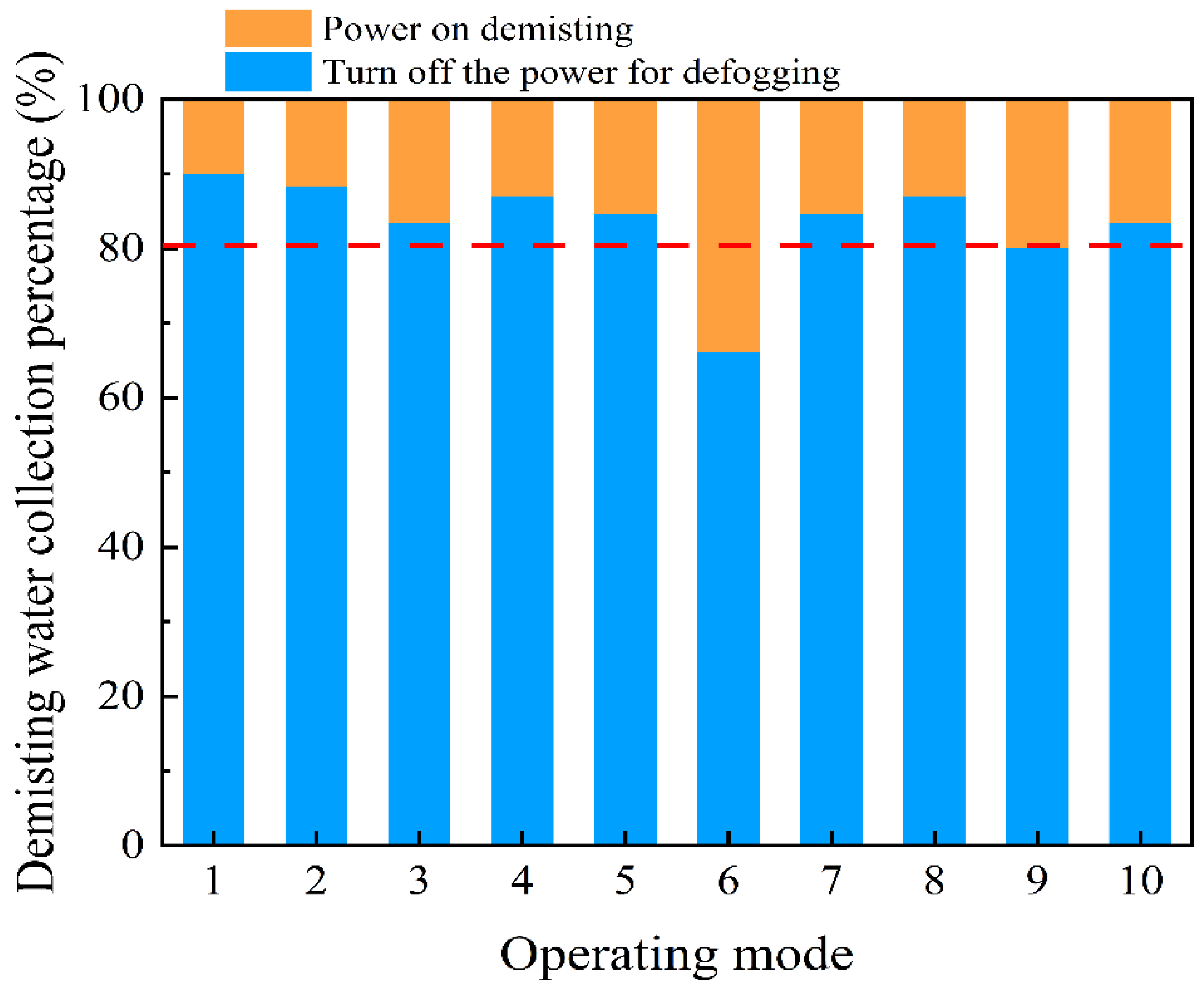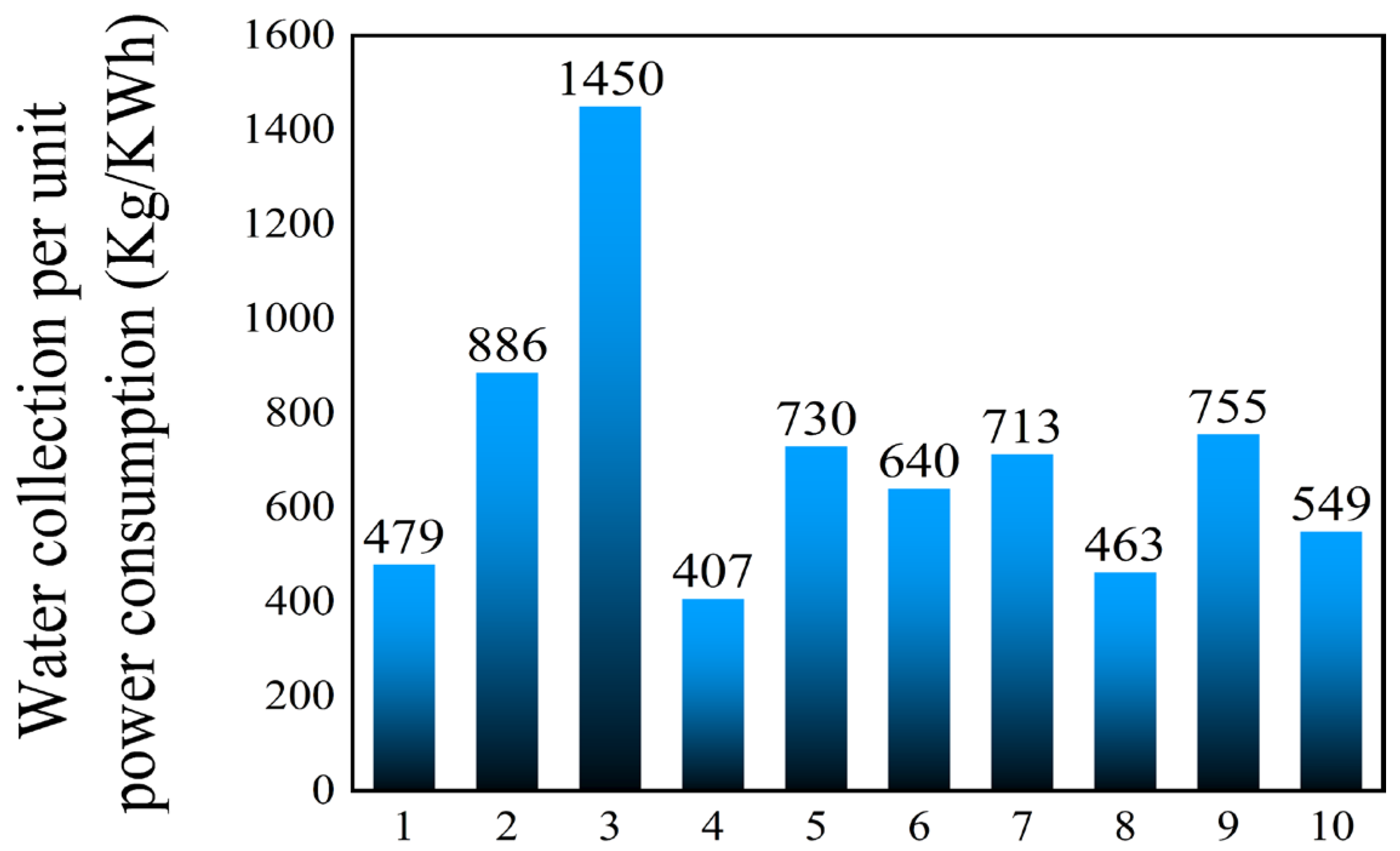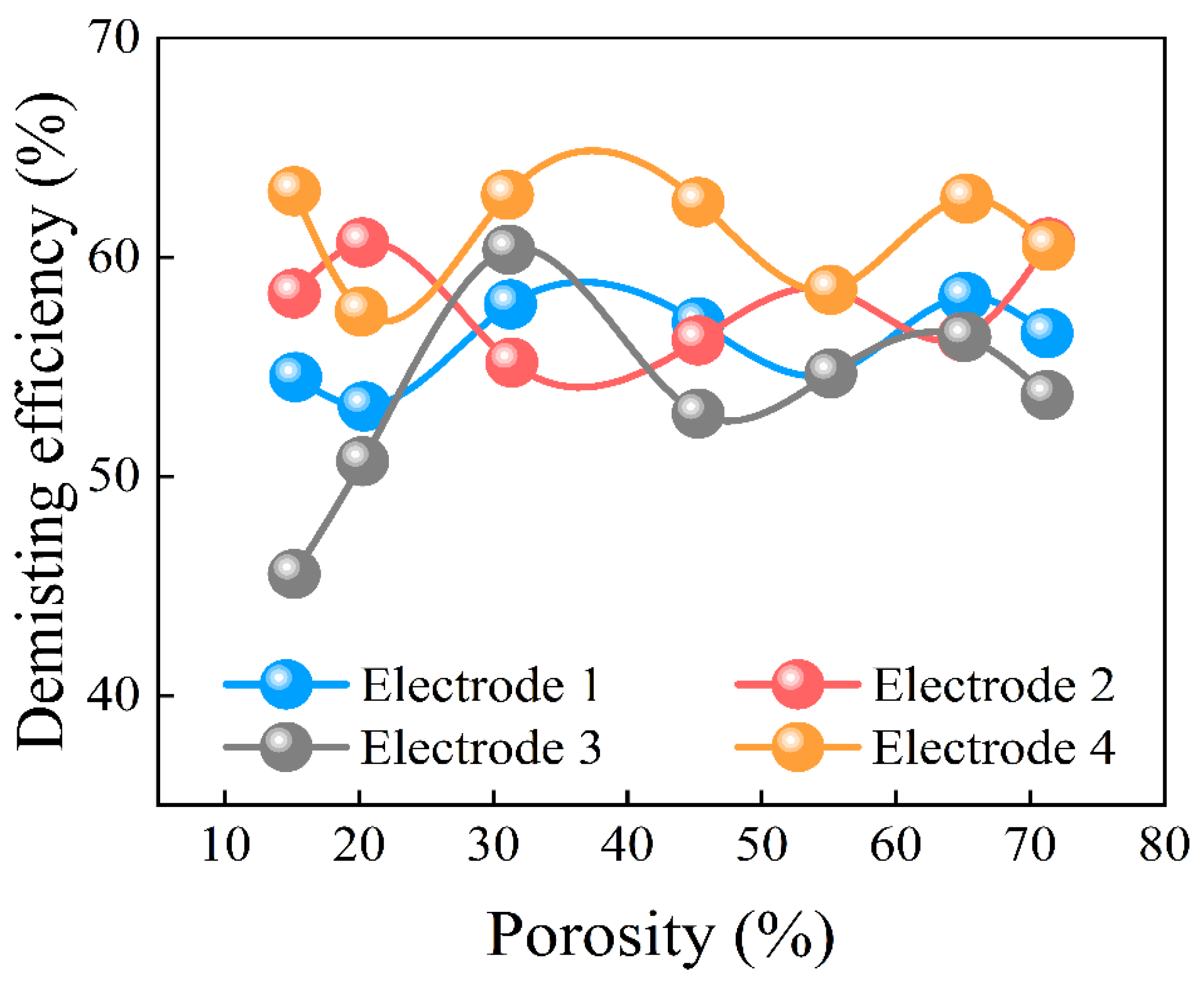Research on New Whitening and Water-Saving Technology Based on Industrial Equipment
Abstract
1. Introduction
2. Technical Principles
2.1. Electrostatic Adsorption of Fog Droplets
2.2. Ionic-Wind-Enhanced Condensation
2.3. Droplet Dipole Deflection
3. Experimental Part
3.1. Experimental Equipment
3.2. Experiment Approach
- (1)
- Outdoor side
- (2)
- Indoor side
3.3. Method of Calculation
3.3.1. Theoretical Calculation of Supersaturation
3.3.2. Demisting Efficiency
3.3.3. Electrical Power
4. Results and Discussion
5. Conclusions
Author Contributions
Funding
Data Availability Statement
Conflicts of Interest
References
- Son, H.K.; Ban, C.H. Design of Turbidity Measurement of White Plume using Optical Method. J. Korea Inst. Electron. Commun. Sci. 2020, 15, 1195–1200. [Google Scholar]
- Pan, S.W.; Tang, N.; Hu, J.J.; Kuang, J.F.; Qi, M.; Ye, K. Experimental study on the spray of mercury removal performance of flue gas desulfurization wastewater. Adv. Mater. Res. 2013, 807, 1483–1488. [Google Scholar] [CrossRef]
- Li, X.; Han, J.; Liu, Y.; Dou, Z.; Zhang, T.A. Summary of research progress on industrial flue gas desulfurization technology. Sep. Purif. Technol. 2022, 281, 119849. [Google Scholar] [CrossRef]
- Kang, Y.; Liu, C.; Zhang, Y.Z.; Xing, H.W.; Zhao, K. Flue gas circulating sintering based on biomass fuel on reduction of NOx and SO2 emission. ISIJ Int. 2020, 60, 1633–1640. [Google Scholar] [CrossRef]
- Xiong, S.; Chen, J.; Liu, H.; Si, W.; Peng, Y.; Wu, X.; Liu, H.; Li, J. Advances in the treatment of multi-pollutant flue gas in China’s building materials industry. J. Environ. Sci. 2023, 123, 400–416. [Google Scholar] [CrossRef] [PubMed]
- Wang, D.; Bao, A.; Kunc, W.; Liss, W. Coal power plant flue gas waste heat and water recovery. Appl. Energy 2012, 91, 341–348. [Google Scholar] [CrossRef]
- Chen, H.; Zhou, Y.; Su, X.; Cao, S.; Liu, Y.; Gao, D.; An, L. Experimental study of water recovery from flue gas using hollow micro–nano porous ceramic composite membranes. J. Ind. Eng. Chem. 2018, 57, 349–355. [Google Scholar] [CrossRef]
- Sijbesma, H.; Nymeijer, K.; van Marwijk, R.; Heijboer, R.; Potreck, J.; Wessling, M. Flue gas dehydration using polymer membranes. J. Membr. Sci. 2008, 313, 263–276. [Google Scholar] [CrossRef]
- Li, X.; Zhou, C.; Li, J.; Lu, S.; Yan, J. Distribution and emission characteristics of filterable and condensable particulate matter before and after a low-low temperature electrostatic precipitator. Environ. Sci. Pollut. Res. 2019, 26, 12798–12806. [Google Scholar] [CrossRef] [PubMed]
- Zhao, S.; Yan, S.; Wang, D.K.; Wei, Y.; Qi, H.; Wu, T.; Feron, P.H. Simultaneous heat and water recovery from flue gas by membrane condensation: Experimental investigation. Appl. Therm. Eng. 2017, 113, 843–850. [Google Scholar] [CrossRef]
- Pandiyarajan, V.; Pandian, M.C.; Malan, E.; Velraj, R.; Seeniraj, R.V. Experimental investigation on heat recovery from diesel engine exhaust using finned shell and tube heat exchanger and thermal storage system. Appl. Energy 2011, 88, 77–87. [Google Scholar] [CrossRef]
- Zhang, Q.; Zhu, Q.; He, Y. Application of Enamel Heat Exchange Tube in MGGH of Coal-fired Power Generating Units. Zhejiang Electr. Power 2016, 9, 57–61. [Google Scholar] [CrossRef]
- Chen, Q.; Finney, K.; Li, H.; Zhang, X.; Zhou, J.; Sharifi, V.; Swithenbank, J. Condensing boiler applications in the process industry. Appl. Energy 2012, 89, 30–36. [Google Scholar] [CrossRef]
- Goel, N. Design and Performance Analyses of Condensing Heat Exchangers for Recovering Water and Waste Heat from Flue Gas; Lehigh University: Bethlehem, PA, USA, 2012. [Google Scholar]
- Terhan, M.; Comakli, K. Design and economic analysis of a flue gas condenser to recover latent heat from exhaust flue gas. Appl. Therm. Eng. 2016, 100, 1007–1015. [Google Scholar] [CrossRef]
- Li, Y.; Yan, M.; Zhang, L.; Chen, G.; Cui, L.; Song, Z.; Chang, J.; Ma, C. Method of flash evaporation and condensation–heat pump for deep cooling of coal-fired power plant flue gas: Latent heat and water recovery. Appl. Energy 2016, 172, 107–117. [Google Scholar] [CrossRef]
- Zhu, K.; Xia, J.; Xie, X.; Jiang, Y. Total heat recovery of gas boiler by absorption heat pump and direct-contact heat exchanger. Appl. Therm. Eng. 2014, 71, 213–218. [Google Scholar] [CrossRef]
- Li, F.; Duanmu, L.; Fu, L. Application of absorption heat pump and direct-contact heat exchanger to advancedrecovery flue-gas waste heat for gas boiler. Sci. Technol. Built Environ. 2018, 25, 149–155. [Google Scholar]
- Li, X.; Zhang, X.; Wang, G.; Cao, R. Research on ratio selection of a mixed liquid desiccant: Mixed LiCl–CaCl2 solution. Sol. Energy 2008, 82, 1161–1171. [Google Scholar] [CrossRef]
- Westerlund, L.; Hermansson, R.; Fagerström, J. Flue gas purification and heat recovery: A biomass fired boiler supplied with an open absorption system. Appl. Energy 2012, 96, 444–450. [Google Scholar] [CrossRef]
- Chua, H.T.; Toh, H.K.; Malek, A.; Ng, K.C.; Srinivasan, K. Improved thermodynamic property fields of LiBr–H2O solution. Int. J. Refrig. 2000, 23, 412–429. [Google Scholar] [CrossRef]
- Conde, M.R. Properties of aqueous solutions of lithium and calcium chlorides: Formulations for use in air conditioning equipment design. Int. J. Therm. Sci. 2004, 43, 367–382. [Google Scholar] [CrossRef]
- Deng, W.; Sun, F.; Chen, K.; Zhang, X. The study on plume abatement and water saving of hybrid mechanical draft wet cooling tower. Appl. Therm. Eng. 2023, 223, 120013. [Google Scholar] [CrossRef]
- Morrison, F. Saving Water with Cooling Towers. ASHRAE J. 2015, 57, 20–33. [Google Scholar]
- Kawada, Y.; Shimizu, H. Reduction of suspended particles in closed space with electrostatic precipitator. Electron. Commun. Jpn. 2017, 100, 32–40. [Google Scholar] [CrossRef]







| Symbol | Definition | Unit |
|---|---|---|
| d | Moisture content | g/kg |
| T | Temperature | °C |
| V | Volumetric flow rate | m3/h |
| ρ | Density | kg/m3 |
| φ | Relative humidity | % |
| η | Efficiency | % |
| h | Specific enthalpy | kJ/kg |
| m | Mass flow | kg/s |
| P | Pressure | MPa |
| in | Indoor side humid air | - |
| out | Outdoor side humid air | - |
| 0 | Indoor environment | - |
| dry | Dry bulb | - |
| wet | Wet bulb | - |
| Absolute Amount of Water Received (kg) | Power (W) | Energy Consumption Output (kg/kW·h) |
|---|---|---|
| 0.012 | 0.018 | 121 |
| 0.015 | 0.0986 | 304 |
| 0.014 | 0.0564 | 496 |
| 0.013 | 0.0566 | 458 |
| 0.008 | 0.225 | 70 |
| 0.019 | 0.1416 | 268 |
| 0.031 | 0.0895 | 692 |
| 0.015 | 0.0663 | 452 |
| Supersaturation | Porosity (%) | Water Collection Capacity (kg) | Water Collection Rate (%) | |||||
|---|---|---|---|---|---|---|---|---|
| kg/h (Not Deducted) | kg/h (Deducted) | g/m3 (Not Deducted) | g/m3 (Deducted) | g/kg (Not Deducted) | g/kg (Deducted) | |||
| 8.22 | 6.25 | 6.01 | 4.57 | 5.77 | 4.39 | 55 | 3.295 | 52.720 |
| 70 | 3.643 | 58.280 | ||||||
| 80 | 2.861 | 45.782 | ||||||
| 90 | 2.028 | 32.450 | ||||||
| 4.38 | 3.76 | 3.20 | 2.75 | 2.91 | 2.50 | 55 | 1.844 | 49.042 |
| 70 | 1.779 | 47.316 | ||||||
| 80 | 1.562 | 41.540 | ||||||
| 90 | 0.983 | 26.136 | ||||||
| 13.57 | 10.48 | 9.94 | 7.676 | 10.41 | 7.85 | 55 | 4.861 | 46.380 |
| 70 | 4.467 | 42.626 | ||||||
| 80 | 3.537 | 33.754 | ||||||
| 90 | 2.267 | 21.632 | ||||||
| 11.17 | 8.23 | 8.105 | 5.97 | 8.34 | 6.145 | 55 | 3.609 | 43.851 |
| 70 | 3.490 | 42.410 | ||||||
| 80 | 3.305 | 40.155 | ||||||
| 90 | 2.479 | 30.121 | ||||||
| 17.95 | 15.86 | 13.22 | 11.69 | 12.38 | 10.94 | 55 | 1.623 | 10.234 |
| 70 | 1.430 | 9.014 | ||||||
| 80 | 1.184 | 7.468 | ||||||
| 90 | 0.691 | 4.357 | ||||||
| 20.49 | 17.314 | 15.23 | 12.87 | 15.25 | 12.89 | 55 | 1.924 | 11.110 |
| 70 | 1.500 | 8.661 | ||||||
| 80 | 1.182 | 6.825 | ||||||
| 90 | 0.791 | 4.568 | ||||||
| 16.40 | 14.57 | 12.09 | 10.75 | 11.04 | 9.816 | 55 | 2.044 | 14.031 |
| 70 | 2.072 | 14.221 | ||||||
| 80 | 1.272 | 8.733 | ||||||
| 90 | 0.720 | 4.942 | ||||||
| 15.70 | 11.91 | 11.43 | 8.675 | 12.31 | 9.34 | 55 | 3.934 | 33.027 |
| 70 | 3.808 | 31.970 | ||||||
| 80 | 3.053 | 25.634 | ||||||
| 90 | 1.925 | 16.161 | ||||||
| 17.02 | 13.115 | 12.28 | 9.46 | 16.2 | 12.49 | 55 | 3.595 | 27.413 |
| 70 | 3.184 | 24.277 | ||||||
| 80 | 2.825 | 21.539 | ||||||
| 90 | 1.437 | 10.957 | ||||||
| 15.32 | 11.08 | 11.22 | 8.11 | 12.51 | 9.05 | 55 | 3.957 | 35.717 |
| 70 | 3.730 | 33.660 | ||||||
| 80 | 3.338 | 30.123 | ||||||
| 90 | 1.922 | 17.349 | ||||||
| 14.54 | 10.91 | 10.363 | 7.78 | 11.06 | 8.3 | 55 | 4.151 | 38.050 |
| 70 | 3.974 | 36.421 | ||||||
| 80 | 3.722 | 34.12 | ||||||
| 90 | 3.478 | 31.88 | ||||||
Disclaimer/Publisher’s Note: The statements, opinions and data contained in all publications are solely those of the individual author(s) and contributor(s) and not of MDPI and/or the editor(s). MDPI and/or the editor(s) disclaim responsibility for any injury to people or property resulting from any ideas, methods, instructions or products referred to in the content. |
© 2024 by the authors. Licensee MDPI, Basel, Switzerland. This article is an open access article distributed under the terms and conditions of the Creative Commons Attribution (CC BY) license (https://creativecommons.org/licenses/by/4.0/).
Share and Cite
Chai, Y.; Jiang, W.; Zheng, X. Research on New Whitening and Water-Saving Technology Based on Industrial Equipment. Energies 2024, 17, 1052. https://doi.org/10.3390/en17051052
Chai Y, Jiang W, Zheng X. Research on New Whitening and Water-Saving Technology Based on Industrial Equipment. Energies. 2024; 17(5):1052. https://doi.org/10.3390/en17051052
Chicago/Turabian StyleChai, Yufei, Weiting Jiang, and Xin Zheng. 2024. "Research on New Whitening and Water-Saving Technology Based on Industrial Equipment" Energies 17, no. 5: 1052. https://doi.org/10.3390/en17051052
APA StyleChai, Y., Jiang, W., & Zheng, X. (2024). Research on New Whitening and Water-Saving Technology Based on Industrial Equipment. Energies, 17(5), 1052. https://doi.org/10.3390/en17051052





